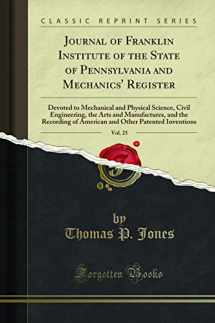
Journal of Franklin Institute of the State of Pennsylvania and Mechanics' Register, Vol. 25: Devoted to Mechanical and Physical Science, Civil Engineering, the Arts and Manufactures, and the Recording of American and Other Patented Inventions
ISBN-13:
9781331944935
ISBN-10:
1331944937
Author:
Thomas P. Jones
Publication date:
2020
Publisher:
Forgotten Books
Format:
Paperback
456 pages
FREE US shipping
Book details
ISBN-13:
9781331944935
ISBN-10:
1331944937
Author:
Thomas P. Jones
Publication date:
2020
Publisher:
Forgotten Books
Format:
Paperback
456 pages
Summary
Journal of Franklin Institute of the State of Pennsylvania and Mechanics' Register, Vol. 25: Devoted to Mechanical and Physical Science, Civil Engineering, the Arts and Manufactures, and the Recording of American and Other Patented Inventions (ISBN-13: 9781331944935 and ISBN-10: 1331944937), written by authors
Thomas P. Jones, was published by Forgotten Books in 2020.
With an overall rating of 3.7 stars, it's a notable title among other
books. You can easily purchase or rent Journal of Franklin Institute of the State of Pennsylvania and Mechanics' Register, Vol. 25: Devoted to Mechanical and Physical Science, Civil Engineering, the Arts and Manufactures, and the Recording of American and Other Patented Inventions (Paperback) from BooksRun,
along with many other new and used
books
and textbooks.
And, if you're looking to sell your copy, our current buyback offer is $0.33.
Description
Excerpt from Journal of Franklin Institute of the State of Pennsylvania and Mechanics' Register, Vol. 25: Devoted to Mechanical and Physical Science, Civil Engineering, the Arts and Manufactures, and the Recording of American and Other Patented InventionsDr. Hare, no doubt unintentionally, entirely misstates my views, when he says that I "think it expedient to have it enter near or through the floor." This represents me as writing nonsense - for do I not speak distinctly against letting it pass through a hole or grate in the floor? and surely this would be "near or through the floor." The principle that I want to establish is, that the flues or pipes by which the heated air passes off from the heat-chamber, into the apartment to be warmed, in whatever direction they be carried under and through the floor, should not terminate there, but pass above the floor, and there have a horizontal direction, (or parallel with the floor) to some extent, before they terminate. What specific length this horizontal branch should have, it would require many experiments to establish. My horizontal branches were six inches long, as stated in my essay. When I spoke of giving this horizontal direction to the hot air, whilst it was yet in a constrained passage, I thought that if my language was not sufficiently explicit, that the apparatus which I applied and described, would make it plain enough - at any rate, it was intended to convey what I have now in other words described above. The momentum or force which I contend the heated air has, when it issues from the heat-chamber - and which I say so powerfully contributes to carry it to the ceiling, when it passes through a mere opening or openings in the floor, I see Dr. Hare destroys by his arrangement of many small perforations; for, if I understand his language, all his openings, distributed over a surface of thirty feet, are mere openings in the floor, covered with perforated plates, and do not change the vertical current of heated air. Now, for this arrangement of Dr. Hare's I cheerfully concede to him all the credit it deserves, and grant too that he adopted it not by accident, but upon reflection, and upon principles that he perfectly understands. But I beg leave to assure him, that if he thinks that these views are parallel with mine, that he has neither by accident nor reflection fallen on my views. The momentum or force I speak of is a very desirable agent with me - I do not wish to destroy it, - but to apply it to a very useful purpose, and on this I build my claims of discovery. By bringing the heated air into the horizontal branch or branches of flues, this force is expended in carrying the heated air over the apartment, and into every part of it; that it does this, I have sufficiently established. The column of hot air, as it passes from the flue, meeting with the resistance of the atmosphere, produces a spray, analogous to the spray of water from the branch pipe of a fire engine, and is in this way divided into many parts, and commingles thus with the cold - air every small division passing in the desired direction, until the momentum is expended. And as a part of the spray from a fire engine, when the column of water first divides (the branch pipe being held horizontally) passes upwards contrary to its own gravity, so a part of the spray of heated air passes downwards; as may be readily seen in my arrangement. The horizontal pipes are six inches from the floor, and yet small light articles are blown along the floor to its very extremity. Although my horizontal pipes are six inches above the floor, I feel convinced that it is best to have them much nearer, as I stated in my former essay. To cover my horizontal branches or flues with plates, replete with many perforations, would be as unwise as to cover with a similar plate the branch pipe of a fire-engine.


We would LOVE it if you could help us and other readers by reviewing the book
Book review

Congratulations! We have received your book review.
{user}
{createdAt}
by {truncated_author}


